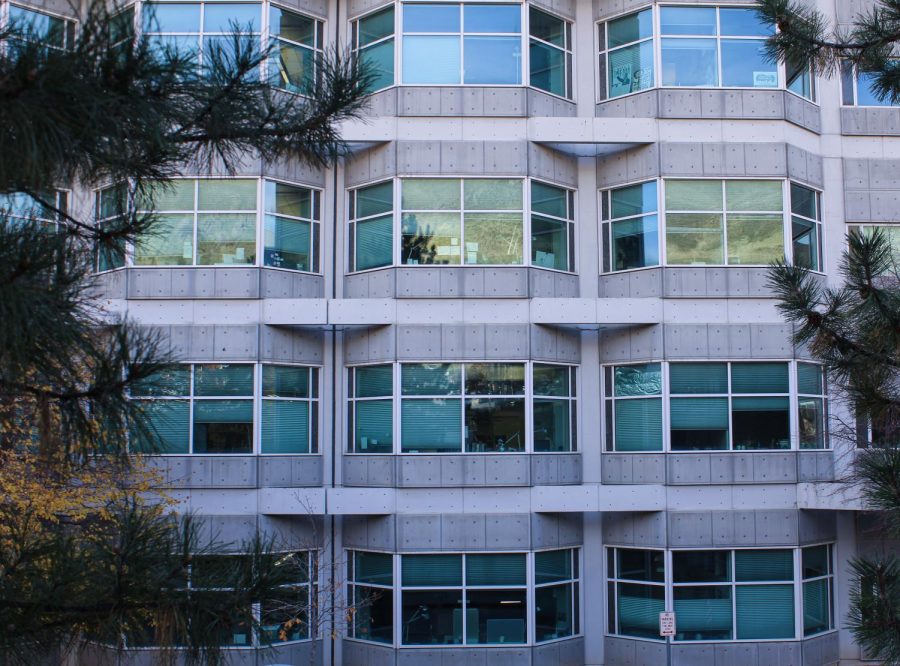2007 Nobel Prize Recipient Mario Capecchi on 2021 Award in Same Field
The Eccles Institute of Human Genetics located at the University of Utah Campus in Salt Lake City, on Friday, November 5, 2021 (Photo by Brooklyn Critchley | The Daily Utah Chronicle)
November 17, 2021
Each year thousands of professors, members of national committees, Nobel laureates, and parliamentary assemblies lobby their candidates to the Nobel committee for the Nobel Prize. The results of this year’s selection were announced on Oct. 8 by The Norwegian Nobel Committee for research that the committee describes as “having conferred the greatest benefit on mankind.”
Mario Capecchi, professor in the Department of Human Genetics and adjunct professor in the Department of Oncological Sciences at the University of Utah, is familiar with the process of winning a Nobel Prize. In 2007, Cappechi won the Nobel Prize in Physiology or Medicine for discovering a method to create “knockout mice,” which are mice with a specific gene turned off.
This technology, developed by Capecchi and collaborators, helped usher in a new era in biology where genes could be turned off and on in order to see the effects on the mice. Today, this technology is used in labs all over the world to investigate genomics, mechanisms for cancer and the very foundations of human development.
Winning the Nobel prize is one of the highest accolades in science.
“It’s a recognition of what you’ve accomplished,” Dr. Capecchi explained, “and it is very pleasing to win. In my case, the concept [for knockout mice] was long going; it took over 10 years to get there. We knew that we could win the Nobel prize with it. When we submitted these experiments to the NIH (National Institute of Health), they thought they were impossible and, therefore, we didn’t get any money. But, we knew that if we succeeded, we would have an impact because you could do the things that you never imagined before. By looking at the effects of changing a piece of DNA over and over again, all in different places, you can start to see what a gene is doing and what it is they are required for.”
Like many winners of the Nobel Prize, Capecchi was both one of the first and last people to find out.
“The Nobel committee called me at 3 o’clock in the morning,” Capecchi said. “And my wife was the first to pick up the phone. It was a person with a foreign accent that she couldn’t quite understand, so she hung up. Luckily, this person was persistent and called back. So, I listened for a while and figured out what was going on. And then, about half an hour later, there were about 30 press people at the door.”
Capecchi described winning as “Incredible. It’s always a surprise because you don’t know what’s happening. You can imagine that the dynamics of 50 people hearing about it at the same time; it’s unpredictable.”
This year, the Nobel Prize in Physiology or Medicine was awarded jointly to David Julius, at the University of California, San Francisco, and Ardem Patapoutian, at Scripps Research in La Jolla, California, for their discoveries of receptors for temperature and touch.
“Their research gives us a clue as to the things that any organism can do: sense their environment,” Capecchi said. “In this particular case, these researchers discovered that when you push on a cell, the cell can sense that you are pushing on it. They discovered ways in which the sense of touch works, which is important when a cell judges its environment by feeling and sensing, and their findings on the mechanical receptors responsible for this is why they won the Nobel prize.”
Erhu Cao, an assistant professor of biochemistry at the U and an expert on sensing receptors, was proud to see his field awarded the 2021 Nobel Prize in Physiology or Medicine.
“[I’m] glad that David Julius and Ardem Patapoutian were jointly awarded the Nobel prize for their contribution to sensory biology,” said Cao in an email interview. “The general public should also be excited about their discoveries because we all interact with our environment via complex sensory systems and sensation of temperature, pain, and touch is our daily experience.”
Cao also broke down the significance of the research that was awarded the 2021 Nobel Prize.
“David Julius identified the TRPV1 receptor and Ardem Patapoutian discovered the Piezo receptor, which represents landmark achievements in understanding sensing of temperature, pain, and touch,” Cao said.
According to Cao, the findings of Julius and Patapoutian are significant in understanding the fundamentals of how life perceives the world around it.
“The discovery of the protein molecules that detect these signals lay the foundation to study their structures and their modulation by pharmacological agents,” Cao said. “The ability to sense temperature, pain-producing stimuli and mechanical force is fundamental to all living organisms. It can be argued that the sense of temperature, pain, and touch is as important as vision, smell, and taste.”














Emma • Nov 19, 2021 at 10:30 am
There’s a great feature about Dr. Capecchi’s history and research in the U magazine: https://continuum.utah.edu/back_issues/2007winter/feature3.html